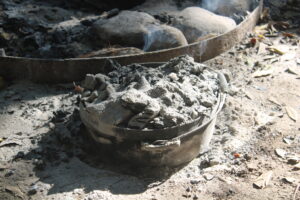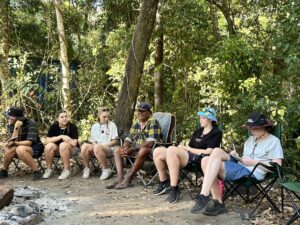
Cape York 2024 Student Immersion
This week we return to Behind the Green Gate with a few more reflections from our Cape York Immersion travellers.
The Year 11s from the Red Group, Aida Tristram, Luella Walsh and Charlotte Wollard share with us their thoughts and experiences.
Cape York Reflection
Aida Tristram
This trip to me was not just a chance to camp with friends, but a chance to experience and immerse myself in the depths and peace of traditional land and Aboriginal way of life. Through stories and cultural practices, I was able to participate in with Ian, Tim, and Elaine in Kalkajaka and Panamunji Homelands, I was given the chance to deepen my understanding of Indigenous knowledge. Sitting down on the Kalkajaka black boulders, around the campfire eating damper, and watching the clouds settle behind the Panamunji landscape allowed me to develop a greater skill and appreciation for respecting traditional land and community. I felt the history imbedded in nature beneath my feet, and by sitting and listening to historical harmony echoing off the environment, I found comfort in sketching some trees.

Luella Walsh
From 29 September to 7 October a group of students including myself, travelled to Cape York. During our immersion, we experienced a once in a lifetime opportunity. Visiting two homelands, Kalkajaka and Panamuunji, these homelands had a significant impact on me, transforming my perspective on life. Over the nine days of travelling with the Red Group, I was able to form meaningful connections with the Elders while also building relationships with the year below.
With an early morning 4am flight we departed from Sydney airport and started our journey, travelling to remote Indigenous communities in far North Queensland. When we arrived at our first homeland Kalkajaka we were greeted by our first elder Ian, as he welcomed us to his homeland and Country, we learnt that his welcoming would protect us and acknowledge that we were visitors on this sacred Indigenous land. As we partook in many cultural activities such as making damper and walking around the homeland looking for bush tucker, Ian guided us towards the green ants known as yunga in Ian’s language. We tried these live ants which had a sour taste to them.
Leaving Kalkajaka we said our goodbyes to Ian and Monday (the dog). With a day’s worth of travel ahead of us we took off on the massive 4-wheel drive bus. Our journey continued to our second homeland, where we were greeted by Tim and a Welcome to Country Smoking Ceremony. Tim is one of the Traditional Owners at Panamuunji. We met his wife Elaine later that night. As we gathered around the fire most nights Tim and Elaine shared their personal stories to our group, from childhood stories to stories they experienced throughout their life. As our time together with Tim and Elaine came to an end, we were lucky enough to experience a language lesson with Elaine. This was important to both Elaine and the group as we helped to keep her language, the Guugu Yimithirr language.
Throughout my journey experienced at both Kalkajaka and Panamuuji it has deepened my understanding and appreciation of Indigenous cultures. This experience has been transformative, broadening my perspective and deepening my commitment to cultural understanding and reconciliation. Having the opportunities to visit the homelands and communities this has given me a profound insight into traditions and cultures continued to be practised today. I was inspired by the deep connection to Land, and the stories passed down through generations.
Charlotte Woollard
In the Term 3 holidays last year myself and 23 others went on an immersion to Cape York, being graciously invited into two homelands- Panamunji & Kalkajaka. We got to engage in various aspects of Indigenous culture, an experience I guarantee none of us will forget. Learning about Indigenous culture firsthand gave me the opportunity to learn new insights and listen to stories passed down from the Traditional Owners and their families. I was surprised to feel so refreshed and at ease without my phone or other technology, an aspect that was completely different from my expectations. This gave me the opportunity to think of how many ways of living there are, giving myself and others the gift of reflection and seeing the world from an unfamiliar perspective.
Our first homeland where we had started our immersion was Kalkajaka and we were warmly greeted by Ian. When I think of Kalkajaka, my fondest memories revolve around campfire talks, bonding with the Year 9s and the amazing scenery of Black Mountain. We participated in activities such as painting and trying green ants on the homeland, as well as travelling further to experience the Cape. We visited Cooktown first and were guided around the museum, learning about the rich Indigenous culture through artefacts and stories as well as other significant historical events such as the Gold Rush and Chinese migration. After this we went to Quarantine Bay and tried our best at fishing, only to be out fished by the sea-whisperer Ian. Ian and the other Red Earth leaders helped us learn how to fish on a hand line, creating a grand total of two catches within the group despite Ian catching a massive fish every single time. These experiences taught me and the other girls many unique skills and practices that have been refined and passed down 60,000 years, making us all feel extremely lucky to have been invited into being taught this. Back at the homeland, we were all in awe of the beauty of Black Mountain right at our doorstep, using this to share ancestral stories and personally reflecting on the trip.
Our second homeland that we visited was Panamuunji, which named after the mountain seen at the entrance of the homeland. Tim and Elaine warmly welcomed us into their home, a sacred space for them that they live on with their family. Panamuunji reminds me of storytelling, having countless laughs and story times around the fire. Whether this was Tim sharing his ancestral stories of country or us sharing impromptu horror stories, many rich experiences involved the art of speech. This homeland was where we worked on our community project, digging trenches to help with two flushing toilets and building a garden bed that utilises wastewater. No matter how many stops needed while shovelling dirt to avoid blistering hands, seeing the final work, and two flushing toilets, complete was worth it. After this, Elaine gave us a language lesson and shared her insights for her vision of reconciliation and empowerment. Her powerful way of speaking and sharing of language undoubtedly inspired our group and helped to keep her language alive, by being spoken and shared. Panamuunji was an incredibly unique homeland and gave me and the others a great sense of fulfilment and achievement, seeing what progress can be made by hard work from all of us.
















